Finding Philae
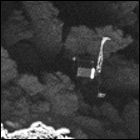 With mere weeks left before the European Space Agency’s Rosetta space probe is shut down, the spacecraft’s gradually decreasing orbit allows it to see more fine detail on the surface of Comet 67P/Churyumov–Gerasimenko, which is now outbound near the orbit of Jupiter. Rosetta’s surface survey finally reveals the fate of the short-lived Philae lander: as ESA engineers suspected in 2014, it came to rest on its side in a crevasse, preventing its batteries from recharging via its solar panels. Originally aimed at the Agilkia region on the larger of Comet 67P’s two “lobes”, Philae’s harpoon anchoring system failed to fire, leaving the lander to bounce helplessly into a ravine on the smaller lobe of the comet, in the Abydos region. It only relayed its surface findings to Rosetta for three days in late 2014. Rosetta would soon join Philae on the surface, with a surface impact scheduled for September 30, 2016.
With mere weeks left before the European Space Agency’s Rosetta space probe is shut down, the spacecraft’s gradually decreasing orbit allows it to see more fine detail on the surface of Comet 67P/Churyumov–Gerasimenko, which is now outbound near the orbit of Jupiter. Rosetta’s surface survey finally reveals the fate of the short-lived Philae lander: as ESA engineers suspected in 2014, it came to rest on its side in a crevasse, preventing its batteries from recharging via its solar panels. Originally aimed at the Agilkia region on the larger of Comet 67P’s two “lobes”, Philae’s harpoon anchoring system failed to fire, leaving the lander to bounce helplessly into a ravine on the smaller lobe of the comet, in the Abydos region. It only relayed its surface findings to Rosetta for three days in late 2014. Rosetta would soon join Philae on the surface, with a surface impact scheduled for September 30, 2016.
Ambition soundtrack
 IDMusic releases Ambition by Atanas Valkov, and album that serves, in part, as the soundtrack to the short film accompanying the European Space Agency’s Rosetta mission to Comet 67P/Churyumov–Gerasimenko.
IDMusic releases Ambition by Atanas Valkov, and album that serves, in part, as the soundtrack to the short film accompanying the European Space Agency’s Rosetta mission to Comet 67P/Churyumov–Gerasimenko.
Philae: first soft landing on a comet
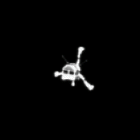 Launched in 2004, the European Space Agency’s Rosetta space probe, orbiting Comet 67P/Churyumov-Gerasimenko in the outer solar system, releases the Philae robotic lander to descend to 67P’s surface. The lander’s harpoon anchoring system doesn’t work entirely as expected, and Philae bounces off the surface and goes spaceborne again for two hours before coming to rest on the comet once more. Though Philae is able to gather scientific data and the first-ever pictures from a comet’s surface, the nearby geography prevents its solar panels from keeping its batteries at a full charge; ESA ground controllers are only able to intermittently contact Philae.
Launched in 2004, the European Space Agency’s Rosetta space probe, orbiting Comet 67P/Churyumov-Gerasimenko in the outer solar system, releases the Philae robotic lander to descend to 67P’s surface. The lander’s harpoon anchoring system doesn’t work entirely as expected, and Philae bounces off the surface and goes spaceborne again for two hours before coming to rest on the comet once more. Though Philae is able to gather scientific data and the first-ever pictures from a comet’s surface, the nearby geography prevents its solar panels from keeping its batteries at a full charge; ESA ground controllers are only able to intermittently contact Philae.
A Deep look into Comet ISON
 NASA’s Deep Impact probe, already a veteran explorer of comets, turns its camera eye toward Comet ISON, a recently-discovered comet expected to put on a spectacular show even to the naked eye in late 2013. Originally launched in 1995 to study Comet Tempel 1 at close range, Deep Impact has since used its cameras to study other comets passing through the solar system. The distance between Deep Impact and Comet ISON at the time the 36-hour photo sequence is taken is roughly 493 million miles.
NASA’s Deep Impact probe, already a veteran explorer of comets, turns its camera eye toward Comet ISON, a recently-discovered comet expected to put on a spectacular show even to the naked eye in late 2013. Originally launched in 1995 to study Comet Tempel 1 at close range, Deep Impact has since used its cameras to study other comets passing through the solar system. The distance between Deep Impact and Comet ISON at the time the 36-hour photo sequence is taken is roughly 493 million miles.
Rosetta at Mars
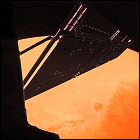 ESA’s unmanned Rosetta space probe, carrying the Philae lander bound for a 2014 rendezvous with Comet 67/P Churyumov–Gerasimenko, makes a gravity-assist flyby of planet Mars to alter its trajectory. As Rosetta will be only 160 miles from the Martian surface at its closest approach, the spacecraft is put into a safe mode for this critical part of its trip, and emerges unscathed. Its next gravity assist will come from Earth itself later in the year.
ESA’s unmanned Rosetta space probe, carrying the Philae lander bound for a 2014 rendezvous with Comet 67/P Churyumov–Gerasimenko, makes a gravity-assist flyby of planet Mars to alter its trajectory. As Rosetta will be only 160 miles from the Martian surface at its closest approach, the spacecraft is put into a safe mode for this critical part of its trip, and emerges unscathed. Its next gravity assist will come from Earth itself later in the year.
Stardust comes home
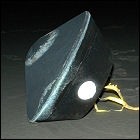 NASA’s unmanned Stardust space probe successfully returns its samples of comet and interstellar dust to Earth. A few minutes after 5:00am Eastern time, the Stardust sample return capsule makes a soft landing in Utah, its record-setting 29,000mph return to Earth slowed by a series of parachutes. (Before Stardust’s return, the fastest vehicle to enter Earth’s atmosphere was the capsule bringing home the crew of Apollo 10 in May 1969.) It is hoped that analysis of the tiny particles captured in cakes of a special porous material called aerogel will shed some light on the origins of the solar system. The “mother ship” portion of the Stardust probe is left on a course that will put it into a permanent orbit around the sun. Stardust was launched in February 1999, and gathered its samples from the cloud of gas and dust surrounding Comet Wild-2 in January 2004, zipping through the comet’s coma at 13,000mph.
NASA’s unmanned Stardust space probe successfully returns its samples of comet and interstellar dust to Earth. A few minutes after 5:00am Eastern time, the Stardust sample return capsule makes a soft landing in Utah, its record-setting 29,000mph return to Earth slowed by a series of parachutes. (Before Stardust’s return, the fastest vehicle to enter Earth’s atmosphere was the capsule bringing home the crew of Apollo 10 in May 1969.) It is hoped that analysis of the tiny particles captured in cakes of a special porous material called aerogel will shed some light on the origins of the solar system. The “mother ship” portion of the Stardust probe is left on a course that will put it into a permanent orbit around the sun. Stardust was launched in February 1999, and gathered its samples from the cloud of gas and dust surrounding Comet Wild-2 in January 2004, zipping through the comet’s coma at 13,000mph.
Colliding with Deep Impact
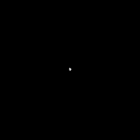 After months on a precise interception course, NASA’s unmanned Deep Impact space probe meets up with Comet Tempel 1, firing a impactor into the comet’s nucleus to study the distribution and composition of the debris scattered by the resulting impact. The impactor had been released by the flyby spacecraft six days earlier, and transmitted its images and readings to the flyby vehicle, which records them and retransmits them to ground controllers on Earth. The two vehicles’ on-board software tracks the comet so precisely that the impact happens within a second of the anticipated timeline in the mission plan, kicking up enough cometary dust to obscure the view of the crater left on the comet’s nucleus. Following the Tempel 1 mission, the still-intact Deep Impact flyby vehicle is redirected for future missions to other objects in the solar system.
After months on a precise interception course, NASA’s unmanned Deep Impact space probe meets up with Comet Tempel 1, firing a impactor into the comet’s nucleus to study the distribution and composition of the debris scattered by the resulting impact. The impactor had been released by the flyby spacecraft six days earlier, and transmitted its images and readings to the flyby vehicle, which records them and retransmits them to ground controllers on Earth. The two vehicles’ on-board software tracks the comet so precisely that the impact happens within a second of the anticipated timeline in the mission plan, kicking up enough cometary dust to obscure the view of the crater left on the comet’s nucleus. Following the Tempel 1 mission, the still-intact Deep Impact flyby vehicle is redirected for future missions to other objects in the solar system.
Launching Deep Impact
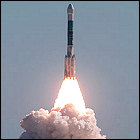 After months of delays in development of its elaborate guidance software system, NASA’s Deep Impact unmanned space probe is launched on a mission to intercept, and fire an impactor into, Comet Tempel 1 half a year later. In order to catch up with the comet, Deep Impact is lofted into orbit by a Delta II rocket, which puts the spacecraft on a precise course at a speed of roughly 64,000mph. Deep Impact will fire the impactor into the comet in July to study the distribution and composition of the debris scattered by the resulting impact.
After months of delays in development of its elaborate guidance software system, NASA’s Deep Impact unmanned space probe is launched on a mission to intercept, and fire an impactor into, Comet Tempel 1 half a year later. In order to catch up with the comet, Deep Impact is lofted into orbit by a Delta II rocket, which puts the spacecraft on a precise course at a speed of roughly 64,000mph. Deep Impact will fire the impactor into the comet in July to study the distribution and composition of the debris scattered by the resulting impact.
Rosetta lifts off
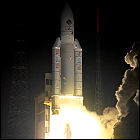 After years of delays that forced a rewrite of the entire mission plan, the European Space Agency launches the Rosetta unmanned space probe on a looping, ten-year journey through the solar system that will hopefully take it to a rendezvous with Comet 67/P Churyumov–Gerasimenko in ten years. The mission plan calls for Rosetta to orbit the comet and release a small lander, Philae, to descend to its surface. In the intervening years, Rosetta will also have opportunities to study Mars and various asteroids as it passes by them. Rosetta’s mission profile is similar to that of NASA’s cancelled 1990s CRAF (Comet Rendezvous / Asteroid Flyby) mission.
After years of delays that forced a rewrite of the entire mission plan, the European Space Agency launches the Rosetta unmanned space probe on a looping, ten-year journey through the solar system that will hopefully take it to a rendezvous with Comet 67/P Churyumov–Gerasimenko in ten years. The mission plan calls for Rosetta to orbit the comet and release a small lander, Philae, to descend to its surface. In the intervening years, Rosetta will also have opportunities to study Mars and various asteroids as it passes by them. Rosetta’s mission profile is similar to that of NASA’s cancelled 1990s CRAF (Comet Rendezvous / Asteroid Flyby) mission.
CONTOUR mission ends in pieces
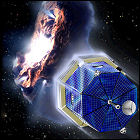 Launched on July 3rd, NASA’s comet-chasing CONTOUR (Comet Nucleus Tour) space probe fails to respond to an all-important, critically-timed command that would send it toward its first rendevous with a comet. As NASA engineers attempt to regain contact, high-powered telescopes pick up what may be a cloud of the $159,000,000 space probe’s debris as it settles into a leisurely orbit around the sun. A definitive cause for the failure of the CONTOUR mission is never found.
Launched on July 3rd, NASA’s comet-chasing CONTOUR (Comet Nucleus Tour) space probe fails to respond to an all-important, critically-timed command that would send it toward its first rendevous with a comet. As NASA engineers attempt to regain contact, high-powered telescopes pick up what may be a cloud of the $159,000,000 space probe’s debris as it settles into a leisurely orbit around the sun. A definitive cause for the failure of the CONTOUR mission is never found.
Jupiter eats a comet
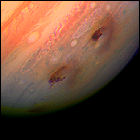 Its collision with the solar system’s largest planet predicted over a year in advance, the fragments of Comet Shoemaker-Levy 9 begin impacting Jupiter’s atmosphere in an astronomical event lasting six days. With Earth-based telescopes watching, as well as cameras and instruments on the Hubble Space Telescope, Galileo and even Voyager 2, huge explosions are witnessed as the cometary chunks slam into Jupiter’s southern hemisphere at over 200,000 miles per hour, leaving dark “scars” larger than the diameter of Earth visible on the planet’s atmosphere and releasing more heat than the surface of the sun. Galileo is still over a year away from arriving at Jupiter.
Its collision with the solar system’s largest planet predicted over a year in advance, the fragments of Comet Shoemaker-Levy 9 begin impacting Jupiter’s atmosphere in an astronomical event lasting six days. With Earth-based telescopes watching, as well as cameras and instruments on the Hubble Space Telescope, Galileo and even Voyager 2, huge explosions are witnessed as the cometary chunks slam into Jupiter’s southern hemisphere at over 200,000 miles per hour, leaving dark “scars” larger than the diameter of Earth visible on the planet’s atmosphere and releasing more heat than the surface of the sun. Galileo is still over a year away from arriving at Jupiter.
Comet Shoemaker-Levy 9
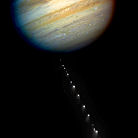 Astronomers on Earth discover a comet like none seen before: having flown close to Jupiter in July 1992, the comet has broken into multiple pieces in a configuration that its discoverers call “a string of pearls.” Calculations of the orbit of the newly detected comet, named Shoemaker-Levy 9 after the team that discovered it, reveal something stunning: the orbit of the fragments will bring them back to Jupiter in just over a year, at which point they are expected to collide with the planet rather than pass it by or go into orbit. Not only does this give Earth-based astronomers time to coordinate observations, but NASA has an ace in the hole: the entire event will be witnessed by the unmanned Galileo probe as it makes its final approach to the giant planet.
Astronomers on Earth discover a comet like none seen before: having flown close to Jupiter in July 1992, the comet has broken into multiple pieces in a configuration that its discoverers call “a string of pearls.” Calculations of the orbit of the newly detected comet, named Shoemaker-Levy 9 after the team that discovered it, reveal something stunning: the orbit of the fragments will bring them back to Jupiter in just over a year, at which point they are expected to collide with the planet rather than pass it by or go into orbit. Not only does this give Earth-based astronomers time to coordinate observations, but NASA has an ace in the hole: the entire event will be witnessed by the unmanned Galileo probe as it makes its final approach to the giant planet.
Pioneer Venus eyes Comet Wilson
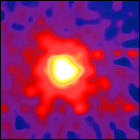 A victory lap after its successful study of Halley’s Comet in 1985 and 1986, the Pioneer Venus Orbiter uses its unique position at the solar system’s second planet to observe another comet, the recently-discovered Comet Wilson. Spotted for the first time only the year before, little is known about Comet Wilson, a lack of data that Pioneer Venus helps to correct by imaging the comet in the ultraviolet portion of the spectrum. Pioneer Venus will also study two other comets later in 1987.
A victory lap after its successful study of Halley’s Comet in 1985 and 1986, the Pioneer Venus Orbiter uses its unique position at the solar system’s second planet to observe another comet, the recently-discovered Comet Wilson. Spotted for the first time only the year before, little is known about Comet Wilson, a lack of data that Pioneer Venus helps to correct by imaging the comet in the ultraviolet portion of the spectrum. Pioneer Venus will also study two other comets later in 1987.
Giotto gets close to Halley’s Comet
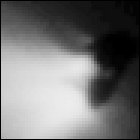 The European Space Agency’s unmanned Giotto space probe makes its closest approach to the nucleus of Halley’s Comet, coming within 400 miles of the comet’s core and taking unprecedented photos that help scientists refine their theories about cometary composition and formation. Giotto pays for the close encounter by taking a beating: its instruments register significant dust impacts, and one impact event jars the spacecraft off of its axis, coming dangerously close to breaking Giotto’s radio contact with Earth and forcing the vehicle to stabilize itself with thrusters. After its encounter with the comet, Giotto falls into a long, looping orbit around Earth, where it will be reactivated to study another comet years later.
The European Space Agency’s unmanned Giotto space probe makes its closest approach to the nucleus of Halley’s Comet, coming within 400 miles of the comet’s core and taking unprecedented photos that help scientists refine their theories about cometary composition and formation. Giotto pays for the close encounter by taking a beating: its instruments register significant dust impacts, and one impact event jars the spacecraft off of its axis, coming dangerously close to breaking Giotto’s radio contact with Earth and forcing the vehicle to stabilize itself with thrusters. After its encounter with the comet, Giotto falls into a long, looping orbit around Earth, where it will be reactivated to study another comet years later.
Vega 2 visits Halley
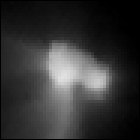 The Soviet Union’s unmanned space probe Vega 2 makes its closest approach to the nucleus of Halley’s Comet, within 5,000 miles of the comet’s icy core. Hundreds of photos are taken and transmitted back to Earth, along with analysis of the dust and gas surrounding the comet. Within a week, Vega 2’s mission is complete, and the probe is allowed to fall into an orbit around the sun as Halley continues to speed back toward the outer solar system.
The Soviet Union’s unmanned space probe Vega 2 makes its closest approach to the nucleus of Halley’s Comet, within 5,000 miles of the comet’s icy core. Hundreds of photos are taken and transmitted back to Earth, along with analysis of the dust and gas surrounding the comet. Within a week, Vega 2’s mission is complete, and the probe is allowed to fall into an orbit around the sun as Halley continues to speed back toward the outer solar system.
Vega 1 visits Halley
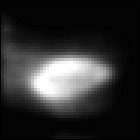 The Soviet Union’s unmanned space probe Vega 1 makes its closest approach to the nucleus of Halley’s Comet, a little over 5,000 miles away (a closer flight path is taken by its twin, Vega 2). Information gathered in the earliest stages of the encounter is shared with the European Space Agency, whose Giotto unmanned probe will make a much closer examination of Halley. Vega 1 registers an immense number of impacts from dust particles, but sustains no serious damage in close proximity to the comet; after several days of observations, Vega 1 is allowed to fall into an orbit around the sun.
The Soviet Union’s unmanned space probe Vega 1 makes its closest approach to the nucleus of Halley’s Comet, a little over 5,000 miles away (a closer flight path is taken by its twin, Vega 2). Information gathered in the earliest stages of the encounter is shared with the European Space Agency, whose Giotto unmanned probe will make a much closer examination of Halley. Vega 1 registers an immense number of impacts from dust particles, but sustains no serious damage in close proximity to the comet; after several days of observations, Vega 1 is allowed to fall into an orbit around the sun.
Pioneer Venus captures Halley’s Comet
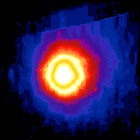 Having already conducted measuresment of Comets Encke and Giacobini-Zinner, the still-functioning Pioneer Venus Orbiter, launched in 1978, becomes the centerpiece of the American effort to gather close-up data on Halley’s Comet. Imaging the comet in ultraviolet light, Pioneer Venus captures Halley from a unique vantage point: both the comet and the planet being orbited by Pioneer are on the opposite side of the sun from Earth, when Halley is at its closest approach to the sun – an event that no other spacecraft is in a position to witness. The Pioneer Venus data will become the most critical data gathered on Halley by an American spacecraft after a planned March 1986 Space Shuttle mission to image the comet from Earth orbit is scrapped in the wake of the Challenger disaster in January.
Having already conducted measuresment of Comets Encke and Giacobini-Zinner, the still-functioning Pioneer Venus Orbiter, launched in 1978, becomes the centerpiece of the American effort to gather close-up data on Halley’s Comet. Imaging the comet in ultraviolet light, Pioneer Venus captures Halley from a unique vantage point: both the comet and the planet being orbited by Pioneer are on the opposite side of the sun from Earth, when Halley is at its closest approach to the sun – an event that no other spacecraft is in a position to witness. The Pioneer Venus data will become the most critical data gathered on Halley by an American spacecraft after a planned March 1986 Space Shuttle mission to image the comet from Earth orbit is scrapped in the wake of the Challenger disaster in January.
Comet Giacobini-Zinner gets ICEd
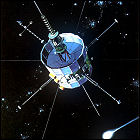 The International Cometary Explorer satellite – originally launched as International Sun-Earth Explorer 3 in 1978 – reaches the culmination of a series of complex orbital changes: a flyby of Comet Giacobini-Zinner, within 5,000 miles of the nucleus, primarily to sample and study the comet’s plasma tail and the interaction between that and the solar wind. ISEE-3 was not equipped with cameras at launch, so no imagery of the comet is obtained. The success of this flyby emboldens mission planners who hope to send it onward to study Halley’s Comet early in 1986, as part of a backup plan to use existing NASA spacecraft to study Halley in lieu of a specialized vehicle that would’ve been launched by space shuttle in 1986 (cancelled in the wake of the Challenger disaster).
The International Cometary Explorer satellite – originally launched as International Sun-Earth Explorer 3 in 1978 – reaches the culmination of a series of complex orbital changes: a flyby of Comet Giacobini-Zinner, within 5,000 miles of the nucleus, primarily to sample and study the comet’s plasma tail and the interaction between that and the solar wind. ISEE-3 was not equipped with cameras at launch, so no imagery of the comet is obtained. The success of this flyby emboldens mission planners who hope to send it onward to study Halley’s Comet early in 1986, as part of a backup plan to use existing NASA spacecraft to study Halley in lieu of a specialized vehicle that would’ve been launched by space shuttle in 1986 (cancelled in the wake of the Challenger disaster).
Giotto comet chaser launched
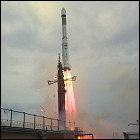 The European Space Agency launches the unmanned Giotto space probe, designed to rendezvous with and observe Halley’s Comet during the comet’s pass through the inner solar system in 1986. The first-ever ESA mission aiming for a target beyond Earth orbit, Giotto is based loosely on the design of ESA’s GEOS satellites, with thick aluminum and Kevlar shielding to help the probe survive potential impacts with cometary matter as it closes in on Halley’s nucleus. Giotto is the first spacecraft ever to use Earth itself for a gravity assist maneuver (which later becomes standard practice with such space vehicles as Galileo, Messenger and Juno). It will go on to become the first vehicle to visit a comet.
The European Space Agency launches the unmanned Giotto space probe, designed to rendezvous with and observe Halley’s Comet during the comet’s pass through the inner solar system in 1986. The first-ever ESA mission aiming for a target beyond Earth orbit, Giotto is based loosely on the design of ESA’s GEOS satellites, with thick aluminum and Kevlar shielding to help the probe survive potential impacts with cometary matter as it closes in on Halley’s nucleus. Giotto is the first spacecraft ever to use Earth itself for a gravity assist maneuver (which later becomes standard practice with such space vehicles as Galileo, Messenger and Juno). It will go on to become the first vehicle to visit a comet.
Vega 2 launched
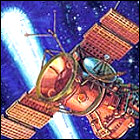 Just days after its twin lifts off, the unmanned Vega 2 space probe is launched by the Soviet Union on a dual mission to drop off a lander at Venus and then to intercept Halley’s Comet in 1986. Derived from the USSR’s earlier Venera Venus landers, Vega 2 will test a refined landing system for landing on Venus by balloon, and will then join an international fleet of unmanned spacecraft attempting to take advantage of Halley’s visit to the inner solar system in late 1985 and early 1986.
Just days after its twin lifts off, the unmanned Vega 2 space probe is launched by the Soviet Union on a dual mission to drop off a lander at Venus and then to intercept Halley’s Comet in 1986. Derived from the USSR’s earlier Venera Venus landers, Vega 2 will test a refined landing system for landing on Venus by balloon, and will then join an international fleet of unmanned spacecraft attempting to take advantage of Halley’s visit to the inner solar system in late 1985 and early 1986.
Vega 1 launched
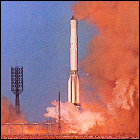 The unmanned Vega 1 space probe is launched by the Soviet Union on a dual mission to drop off a lander at Venus and then to intercept Halley’s Comet in 1986. Derived from the USSR’s earlier Venera Venus landers, Vega will test a refined landing system for landing on Venus by balloon, and will then join an international fleet of unmanned spacecraft attempting to take advantage of Halley’s visit to the inner solar system in late 1985 and early 1986.
The unmanned Vega 1 space probe is launched by the Soviet Union on a dual mission to drop off a lander at Venus and then to intercept Halley’s Comet in 1986. Derived from the USSR’s earlier Venera Venus landers, Vega will test a refined landing system for landing on Venus by balloon, and will then join an international fleet of unmanned spacecraft attempting to take advantage of Halley’s visit to the inner solar system in late 1985 and early 1986.
New assignment for Pioneer Venus
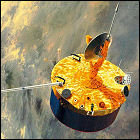 Having received new orders from NASA, the still-functional Pioneer Venus Orbiter – launched in 1978 and in a high, looping orbit over Venus since it ceased active observations of the planet in 1981 – turns its instruments in the direction of Comet Encke, which is currently passing through the inner solar system. Rather than its cameras, the orbiter’s ultraviolet spectrometer is trained on the comet as Earth-based researchers try to determine the composition and rotational speed of Encke’s nucleus. The Pioneer Venus Orbiter will continue to observe other comets through the late 1980s.
Having received new orders from NASA, the still-functional Pioneer Venus Orbiter – launched in 1978 and in a high, looping orbit over Venus since it ceased active observations of the planet in 1981 – turns its instruments in the direction of Comet Encke, which is currently passing through the inner solar system. Rather than its cameras, the orbiter’s ultraviolet spectrometer is trained on the comet as Earth-based researchers try to determine the composition and rotational speed of Encke’s nucleus. The Pioneer Venus Orbiter will continue to observe other comets through the late 1980s.
ISEE-3 to ICE
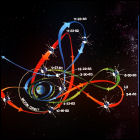 Its primary mission satisfactorily completed, the NASA/ESA ISEE-3 (International Sun-Earth Explorer 3) satellite has a surplus of maneuvering fuel left over, and is given a new mission: it begins a series of over a dozen maneuvers utilizing both thrusters and gravity-assists, intended to push it out of its LaGrange point between Earth and the sun and toward a 1985 rendezvous with Comet Giacobinni-Zinner. Upon its final maneuver in 1983, ISEE-3 will be renamed ICE (International Cometary Explorer) and, after the complex series of course changes, will be perfectly targeted for its 1985 comet encounter.
Its primary mission satisfactorily completed, the NASA/ESA ISEE-3 (International Sun-Earth Explorer 3) satellite has a surplus of maneuvering fuel left over, and is given a new mission: it begins a series of over a dozen maneuvers utilizing both thrusters and gravity-assists, intended to push it out of its LaGrange point between Earth and the sun and toward a 1985 rendezvous with Comet Giacobinni-Zinner. Upon its final maneuver in 1983, ISEE-3 will be renamed ICE (International Cometary Explorer) and, after the complex series of course changes, will be perfectly targeted for its 1985 comet encounter.
ISEE-3
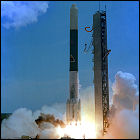 The third in a series of three International Sun-Earth Explorer satellites, a joint effort between NASA and the European Space Agency, is launched aboard a Delta rocket from Cape Canaveral. Unlike the other ISEE satellites, ISEE-3 is intended to take up a “halo” orbit at the L1 LaGrangian point between the sun and Earth, the first man-made space vehicle to do so. There it will study the interaction between the solar wind and Earth’s own magnetosphere. Once its mission is completed in the early 1980s, it will be redirected and renamed to become the first Earth spacecraft to study a comet at close range.
The third in a series of three International Sun-Earth Explorer satellites, a joint effort between NASA and the European Space Agency, is launched aboard a Delta rocket from Cape Canaveral. Unlike the other ISEE satellites, ISEE-3 is intended to take up a “halo” orbit at the L1 LaGrangian point between the sun and Earth, the first man-made space vehicle to do so. There it will study the interaction between the solar wind and Earth’s own magnetosphere. Once its mission is completed in the early 1980s, it will be redirected and renamed to become the first Earth spacecraft to study a comet at close range.
No comet for Voyagers
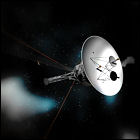 NASA announces that Voyagers 1 and 2 may be in a unique position to study the newly-discovered Comet Kohler 1977 XIV, discovered just days before Voyager 1’s launch. Both Voyagers are expected to pass Comet Kohler at a distance of a little over 1 astronomical unit (AU), equivalent to the distance between Earth and the Sun, in November, and the possibility of examining the comet with their onboard instruments is proposed. This plan is eventually abandoned, since the comet will track near the sun, direct exposure to which could harm the television tube cameras installed aboard each Voyager. The exploration of comets with robotic spacecraft will have to wait until the 1980s.
NASA announces that Voyagers 1 and 2 may be in a unique position to study the newly-discovered Comet Kohler 1977 XIV, discovered just days before Voyager 1’s launch. Both Voyagers are expected to pass Comet Kohler at a distance of a little over 1 astronomical unit (AU), equivalent to the distance between Earth and the Sun, in November, and the possibility of examining the comet with their onboard instruments is proposed. This plan is eventually abandoned, since the comet will track near the sun, direct exposure to which could harm the television tube cameras installed aboard each Voyager. The exploration of comets with robotic spacecraft will have to wait until the 1980s.